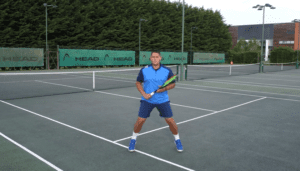No products in the basket.

Roger Federer is considered by many to be the greatest tennis player of all time. But what makes him so good and what can we copy from his game to improve our own?
In this video, coach Simon Konov of Top Tennis Training will break down and analyze some of the key elements that make Federer so good.
The foundation of Federer’s game is his serve. Roger Federer wins 88.8% of all his serve games. Federer uses a platform serve stance, which means he keeps his feet around shoulder-width apart, throughout the entire motion. This will help him with his balance and Federer will be able to use both legs equally as well to drive up into the ball. Federer’s explosive leg drive is the main power source on his serve, by going down and up quickly, without having an extended pause in the knee bend, Federer can generate the maximum ground force and transfer it into the ball.
Roger Federer also has great disguise with his tennis serve, two reasons for this are:
Federer turns his body away from the net, so his back ends up facing the opponent. This makes it very hard for the returner to spot any differences in Federer’s body position so it becomes much harder to read the serve.
Federer uses the same ball toss for each serve. Because he tosses the ball in line with the baseline, from the right side of the court to the left, it creates a rainbow style ball toss which allows Federer to hit each serve (flat, slice and kick) at different points in the toss.
Federer’s serve is not the most powerful but what he lacks in pace, he makes up for in accuracy and disguise.
Federer also has one of, if not the greatest second serve any current pro player. Roger wins 56.8% of all points on his second serve, only second in the history of the game to Rafa Nadal.
Federer hits around 73% of all his baseline winners with his forehand side. His ability to hit with a wide variety of spins is one of the main reasons that he has such a dominant forehand.
Federer can generate very heavy topspin when he wants to, around 4,500 RPM on the ball (revolutions per minute). However, Roger can also hit a much flatter forehand, at around only 1,000 RPM when he wants to be more aggressive.
Roger Federer’s Forehand Grip – The foundation of Federer’s forehand is his eastern forehand grip. This is where the heel pad and index knuckle are on bevel three.
Federer has a great http://windhampharmacy.com unit turn and coils the body very well at the start of the forehand swing, storing energy in the trunk muscles. He also keeps the racket head higher than the grip level when he is preparing for his forehand.
Once he reaches the power position and starts to drop the racket head, the side of the strings Federer will hit the ball with will face the ground. This racket angle will help Federer produce heavy topspin even though he uses an eastern forehand grip. Federer also achieves great racket lag on his forehand, prior to the contact point.